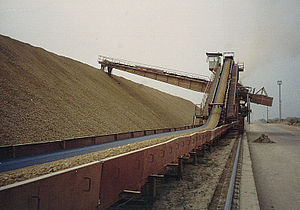
A limestone prehomogenization pile being built with a boom stacker prior to use in Portland cement rawmix
I found a great page on cement making from the Portland Cement Association (portland is a general name for the type of cement we all use):
“Bricklayer Joseph Aspdin of Leeds, England first made portland cement early in the 19th century by burning powdered limestone and clay in his kitchen stove.”
At the bottom of the page on Cement is a link to a Virtual Cement Plant Tour. Click on “Quarry” then the “Raw Materials” button on the Quarry picture. What do you see? Limestone, Clay, and Sand.
Well, I could stop there, but let’s explain what this means about our world.
Old Earth Believers like to tell you that Limestone is formed from seashell fragments. “Limestone is a rock that is composed primarily of calcium carbonate. It can form organically from the accumulation of shell, coral, algal and fecal debris [poop, ewww]. It can also form chemically from the precipitation of calcium carbonate from lake or ocean water.”
Let’s talk about the seashell rock first. Have a look at this little page from James Madison U. on what is called Packed Biosparite [life+ sparite calcite]. “This outcrop is either a reef, or is closely associated with a reef. It was a high energy environment as indicated by the lack of fine-grained sediment (micrite), and the presence of spar cement. Spar is crystalline calcite crystals precipitated by ground water in the spaces between the fossils after deposition. Before this became a rock we can imagine it [did you catch the Fuzzy Words?] as a rubble pile of skeletons lying on the bottom with no other sediment intermixed with them.”
What is a “high energy environment?” Here’s the definition, translated into plain English- A watery environment, swishing violently around, created by waves, currents, or surf, which stopped the little bits of stuff floating in the water from settling to the bottom (so only big bits, like seashells, sank). I’m sure that means there had to be millions of years of gentle, sunny days to slowly cause the formation of these rocks, NOT!
There’s one other thing to mention from the James Madison U. page about fossily limestone, “This is also a coarse, poorly sorted rock, with skeletons of many different sizes jumbled together. A number of scours, erosion surfaces, are also visible indicating periods of very strong currents, most likely storms.” Which means that after the rocks were violent sloshed together by the waves and such, there was even more water scrubbing away at them.
Wikipedia has an “incomplete” list of over 100 locations you can find these kinds of rocks around the world.
Even fine-grained, strong limestone like the Indiana (Bedford) Limestone that covers the Empire State Building is made of billions of tiny sea creature skeletons. “The fine oolitic texture would suggest the sediments were subjected to wave action and marine currents sufficient to winnow the fossil fragments to a uniform size. If one looks closely at the stone you will see it is composed almost entirely of small fragments of marine shells.”
I’ll have to stop here for today because there’s even more to say about limestone than I had guessed!! Stay tuned….
And when he was come nigh, even now at the descent of the mount of Olives, the whole multitude of the disciples began to rejoice and praise God with a loud voice for all the mighty works that they had seen; saying,
Blessed be the King that cometh in the name of the Lord: peace in heaven, and glory in the highest.
And some of the Pharisees from among the multitude said unto him, Master, rebuke thy disciples. And he answered and said unto them, I tell you that,
if these should hold their peace, the stones would immediately cry out. Luke 19:37-40
More posts on Limestone:
Limestone: Travertine and Tufa
Travertine and Tufa: Quotes for the day





8 Comments
Comments are closed.